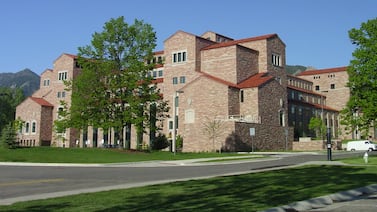This story has been updated to include a comment from the governor.
Colorado lawmakers on the powerful Joint Budget Committee want to provide some financial assistance to schools grappling with educating an influx of migrant students this year.
The idea from state Rep. Emily Sirota, a Denver Democrat who sits on the committee, would allocate up to $24 million, to be split among school districts that have enrolled newly arrived students after the October cutoff date that determines districts’ per-pupil funding. But the funding would be far less than what the state provides to educate a student.
The budget committee, which plays a major role in how the state spends its money, voted unanimously earlier this month to draft a bill allocating the funds.
Sen. Rachel Zenzinger, an Arvada Democrat and vice chair of the committee, said she plans to co-sponsor the bill once it’s ready. The bill has not yet been introduced.
In a statement, a spokesperson for Gov. Jared Polis said he’s working with the legislature on a proposal to provide additional funding for school districts that have new arrivals after the October count date.
The state annually adjusts districts’ education funding up or down during the legislative session based on each district’s student enrollment on Oct. 1. But the surge in migrant students since the official count has overwhelmed many districts and prompted calls from school leaders for more aid to teach recent arrivals.
Sirota said while the state doesn’t have an exact tally, she’s heard estimates of up to 8,000 new student arrivals statewide since October. Some schools have needed to increase class sizes and have a greater need for services that help English learners, she said.
“This crisis is being felt across our cities, counties, and the state,” she said.
The state money would be a one-time infusion for districts. Joint Budget Committee members have said they want to ensure school districts wouldn’t need to apply for the money, but instead would have to provide the state with a tally of eligible students.
How much money districts would get likely will depend on whether the committee decides to allocate the full $24 million Sirota has proposed and how many newly arrived students have enrolled statewide since the October count.
The $24 million sum is not a calculation of how much it costs to fully educate the migrant students in Colorado. Rather, it is money the state would otherwise put in its savings account for education. Increasing local tax revenue means the state needs to spend $24 million less on schools this year than anticipated.
The proposed bill would reallocate those funds, but committee members have said they want to also find other funding sources.
The extra money would help districts, but it would be less than the $10,614 per student, on average, they get for students who are enrolled during the October count.
Sirota said funding is tight this year, especially when there are many competing budget priorities. But the extra funding would help districts bearing the brunt of the costs.
“I want to help our districts better absorb the costs that they are incurring with so many new students who are new to the country that they have taken on since October,” she said.
States across the country have seen a spike in recent migrant arrivals. The Denver area has dealt with the brunt of those arrivals.
In Denver Public Schools, migrant student enrollment has ballooned by more than 3,200 of these young people since the start of the school year. Many arrived after the October count that determined state per-student funding sent by the state.
The impact has also been uneven within the district. New students are concentrated in about two dozen of Denver’s schools.
But schools and cities across the metro area and state are reporting more students arriving every day, either from families moving to find work or recently coming to the state. The influx has caused financial shortfalls and pushback from some communities.
Correction: This story has been corrected to update the per pupil figure districts get from the state.
Jason Gonzales is a reporter covering higher education and the Colorado legislature. Chalkbeat Colorado partners with Open Campus on higher education coverage. Contact Jason at jgonzales@chalkbeat.org.





